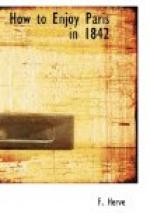We must not miss the Tour de l’Horloge, which is certainly of the middle ages, and the clock is I believe considered the oldest in Paris; turning to the right we view the grand front of the Palais de Justice, a very handsome iron grating in part gilded, decorates the entrance to the front court, and you ascend a bold flight of steps to the principal door; four doric pillars with figures representing Justice, Fortitude, Plenty, and Prudence, adorn the grand facade of the building; an immense hall to the right, in which is a noble statue of the good and venerable Malesherbes, well worth attention, and is the apartment where formerly ambassadors were received and the nuptial ceremonies of princes were celebrated, but now the rendez-vous of lawyers, barristers, and their clients.
Several other halls, chambers, galleries, corridors, etc, are worth notice, and that which is beneath them, has a shuddering kind of interest; it is called the Conciergerie, and if its victims were there consigned by the harsh decree of rigid justice, surely mercy and charity were not allowed to enter, whilst it formed the prison of the hapless Marie Antoinette and the brave Pichegru, but we will draw a veil over those scenes which are but fraught with sad reminiscences. Many of these dark covered alleys, belonging to this extraordinary building, have been long occupied by venders of shoes, slippers and a variety of articles which remind one of the old Exeter Change.
This singular edifice which almost resembles a town is considered to have been founded by Eudes, count of Paris, about the year 890, but the most ancient part now standing, was built by Saint Louis who founded the chapel, which is considered to be a complete type of the pure gothic architecture, and which in that respect is not exceeded by any other in Europe; it has the most decided air of antiquity, with a richness and elegance which certainly characterise it as the beau ideal of that period. It is termed the Holy Chapel and now appropriated to the conservation of ancient records. From this interesting monument we turn with regret, but a new scene bursts upon us; it is the flower market, which is held under trees and furnished with large bassins constantly supplied with water; the numerous display of flowers mostly in pots done up in such a manner with white paper so that it forms the background, gives much light and life to the colours, buds, and blossoms, which bloom on this enlivening spot. Wednesdays and Saturdays are the market days, and I recommend the reader not to miss so pleasing a spectacle. On the Quai du Marche-Neuf, on the southern bank of the island, a very opposite sight may be seen, being the Morgue, a little building for receiving all dead bodies found, and not owned.




